The capabilities that a company needs if it is to excel at data-driven marketing are expanding rapidly. Before the pandemic, a brand armed with basic digital marketing capabilities could devise and execute a fairly mature marketing strategy. But maintaining or improving on this level of maturity has become more difficult in today’s environment, which is marked by rising prices, market volatility, and geopolitical tensions. Advanced technologies such as AI, generative AI (GenAI), cloud computing, consumer data economies, and omnichannel engagement require companies to gain and deploy additional expertise. (See “The Four Disruptors.”)
The Four Disruptors
- AI and Generative AI (GenAI). AI and GenAI enable businesses to harness data for strategic insights and to automate and optimize marketing processes such as media buying, targeting, personalization, and creative production. This leads to more individually tailored and engaging customer experiences. AI and GenAI also contribute to greater efficiency and effectiveness in marketing campaigns.
- Cloud Architecture. Commoditization of technology, along with new and readily available software and AI solutions, is exponentially increasing IT complexity by encouraging a siloed marketing architecture and by triggering regulatory and technological constraints on where and how companies can store data.
- Consumer Data Economies. Data quality and quantity will be essential for the AI models of the future. Companies will require vast quantities of proprietary data to generate unique insights that set their brands apart. In addition, data will underpin many strategic decisions and serve as a valuable monetization asset for brands.
- Omnichannel. In today's market, nearly all consumers have access to technology—such as mobile devices, connected TV (CTV), social media, gaming, augmented and virtual reality experiences, and connected products—on top of traditional advertising and promotion initiatives like TV and out-of-home. This multitude of touchpoints offers new opportunities for sales and engagement, but it also creates an extremely complex environment for marketers to navigate, since consumers’ attention and purchase behaviors can change by touchpoint.
Fortunately, these four disruptors also create a significant opportunity for brands to substantially improve their maturity and, consequently, their productivity, profitability, and overall competitiveness. (See Exhibit 1.) In this report, we outline how brands can advance their marketing maturity to become true innovators, leveraging AI- and GenAI-driven solutions to elevate marketing strategies and automatically optimize creatives and activation.
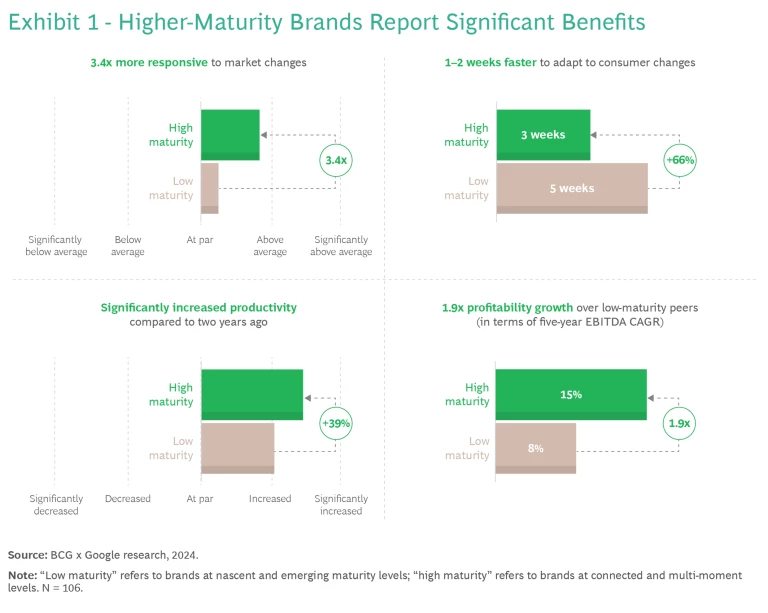
The Need for New Capabilities
Data-driven marketing has evolved quickly since we published our previous report in 2021. To maintain or enhance their maturity, brands must do more to embed data, conduct full-funnel marketing planning (including offline), and deliver technology-enhanced consumer experiences on a daily basis. The challenges are so acute that the average level of marketing maturity actually fell 8% from 2021 to 2024, according to our latest analysis of more than 100 brands in Europe, the Middle East, and Africa. (See “Methodology.”) During the same period, capabilities declined across the board. (See Exhibit 2.)
Methodology
Google and BCG have collaborated since 2018 to uncover and explore the key success factors for marketing maturity, which we have always understood to be a journey, not a destination.
Our goals in 2024 were threefold: to study the shifts in context and trends that influence brands’ marketing maturity; to evaluate the evolution of the capabilities that drive maturity in light of these changing trends; and to understand how mature brands act and develop their resilience to market changes, thus providing a roadmap for less mature companies to emulate.
During our research, we interviewed more than 50 practitioners, including leading EU brand and technology experts, to assess the state of marketing today. We surveyed more than 100 brands in Europe, the Middle East, and Africa across 11 industries to assess how marketing maturity has evolved, and we conducted more than 20 one-on-one executive interviews to assess leaders’ priorities and to gain insight into the reasons underlying certain decisions.
We found that the key enablers of digital marketing continue to evolve, and that it no longer makes sense today to interpret marketing as a static set of capabilities. Instead, the relevant capabilities must continually evolve to unlock benefits holistically. (See the exhibit.)
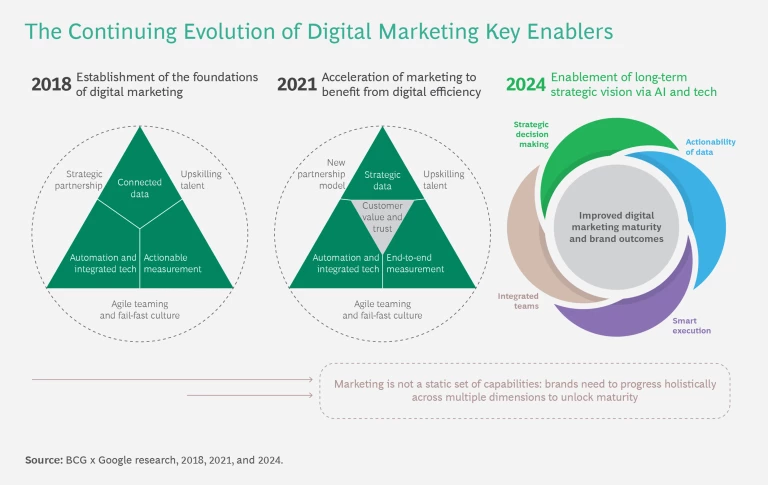
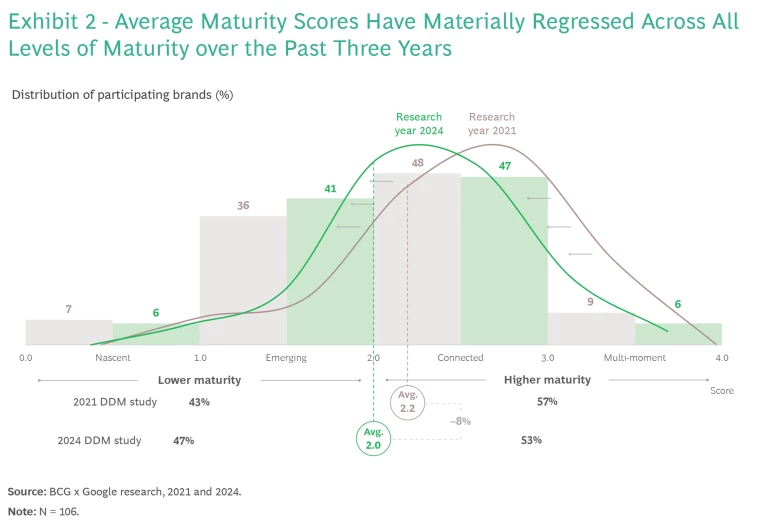
That decline does not necessarily signal that companies have done anything wrong; rather, it indicates that the bar for marketing maturity is constantly rising. Today, a mature marketing operation must be AI- and GenAI-driven. In our 2024 report, we have identified 19 capabilities essential for companies as they develop their marketing maturity.
Based on our research, these 19 capabilities fall into three broad capability categories (see Exhibit 3):
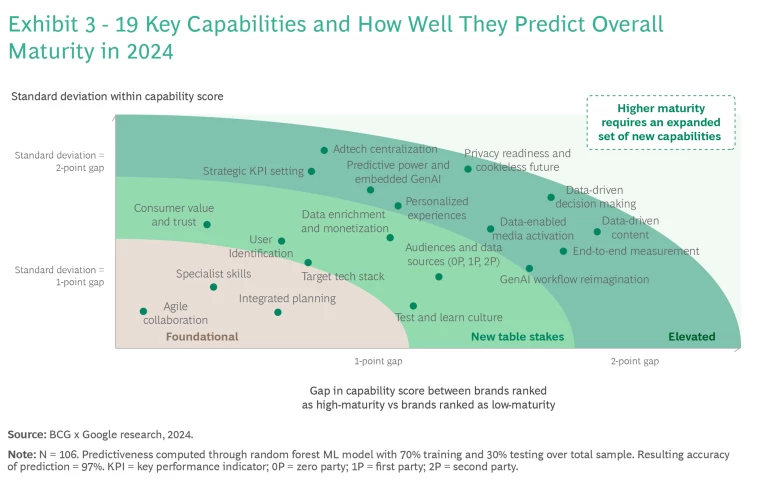
- Foundational Capabilities. These are must-have, baseline capabilities. They enable continuous improvement and learning via advanced ways of working and a capability acquisition model that balances insourcing and outsourcing. Foundational capabilities include agile collaboration, specialist skills, and integrated planning.
- New Table Stakes Capabilities. These capabilities used to be “nice to have,” but they have now become the standard for unlocking value. Brands that lack these capabilities should hurry to acquire them. New table stakes capabilities include user identification, integrated planning, test and learn culture, data enrichment and monetization, and targeting audiences and sources of first-party (1P) and second-party (2P) data.
- Elevated Capabilities. These game-changing capabilities capitalize on new trends and technologies that will drive future growth. Elevated capabilities include privacy readiness (in response to cookie deprecation), end-to-end measurement, personalized experiences (through owned channels), data-enabled media activation (for example, campaign automatization), predictive power and embedded AI (including advanced adoption of AI models for forecasting and planning), data-driven content (content personalization based on targeting), and most recently GenAI workflow reimagination.
Based on brands’ level of maturity across these three sets of capabilities, and in keeping with our previous
digital marketing
analysis, we categorized surveyed companies into four maturity levels that reflect brands’ adoption of and proficiency with the 19 essential capabilities: nascent, emerging, connected, and multi-moment. Regardless of a brand’s current level of maturity, it must focus on building capabilities across all three sets of capabilities described above. However, the most valuable capabilities to develop differ for brands at different maturity levels:
- Nascent. These brands are just beginning their digital and data-driven journeys. They measure marketing results with basic measurement techniques and leverage mostly third-party (3P) data. They recognize the potential value of AI and GenAI but remain in an exploratory phase. As a result, their approach to activation and execution is disconnected across touchpoints.
- Emerging. These brands have taken the first steps toward digital transformation and are now leveraging the returns from their initial investments in marketing maturity to fund the next steps. They have a centralized marketing technology stack, and they integrate online and offline planning for marketing activities. Emerging brands have started to leverage 1P data on top of 3P data for marketing activities, and they tend to buy media that leverages simple AI-driven solutions (for example, AI-driven bidding algorithms).
- Connected. These brands have reached a level of digital and data integration that supports a culture of experimentation. They can align measurement with business key performance indicator (KPI) settings and leverage cloud computing to support AI and GenAI solutions. They can increasingly automate activation and execution, with integrated teams planning seamless consumer journeys.
- Multi-moment. These brands stand out as true innovators in the marketing landscape. In particular, they use advanced technologies (such as AI algorithms for budgeting and optimization and GenAI for content personalization) to support their strategies. They leverage 1P and 3P data across multiple business areas—including marketing, sales, finance, and operations—that are fully supported by cloud infrastructure. They can measure marketing results end-to-end, which enables them to improve targeting and personalization daily.
Companies that find themselves in the first three levels want to move up, and those few that occupy the multi-moment level need to work hard to maintain and improve their position. This task is getting tougher because new marketing capabilities must be developed—constantly raising the bar. Although nascent and emerging brands are relatively strong in foundational capabilities, they have a pronounced deficit in both new table stakes and elevated capabilities. (See Exhibit 4.)
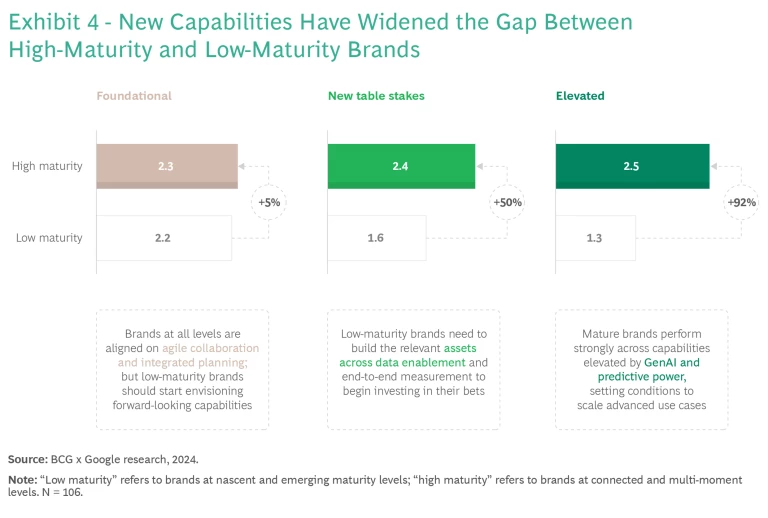
Interestingly, more advanced brands scored higher on elevated capabilities than on foundational capabilities. In fact, their foundational capabilities are only marginally more mature than those of low-maturity companies. This may signal that more mature companies have successfully built on those foundations to develop new and more elevated capabilities, yet they should not take their eyes off foundational capabilities.
Four Practices to Unlock Maturity Benefits
As important as capabilities are, they do not create maturity and value on their own. Brands should avoid building scattered capabilities that lack full integration. Instead, they should acquire capabilities as part of a holistic strategic plan designed to realize the benefits of maturity across the enterprise. We have identified four ways to unlock these new opportunities, each of which requires some of the 19 capabilities that are essential for brands as they develop their AI-driven marketing maturity. (See Exhibit 5.)
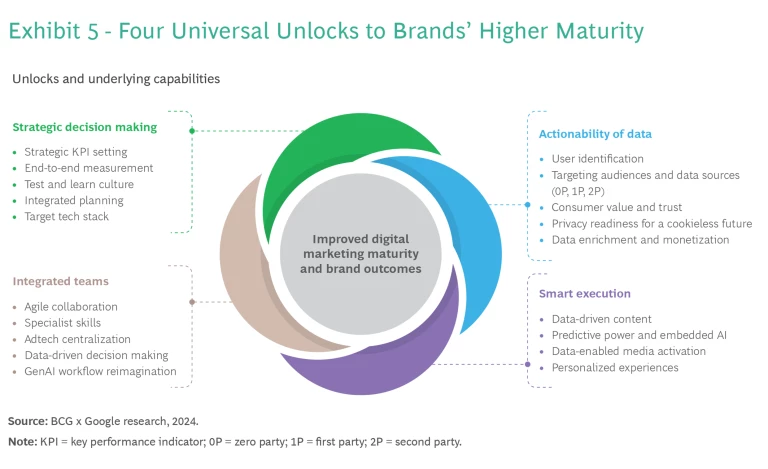
Unlock 1: Enable strategic decision making by linking marketing performances to strategic outcomes through online and offline execution. The capabilities underlying this unlock include strategic KPI setting, integrated planning, end-to-end measurement (across the journey, linking online and offline channels), test-and-learn culture, and target tech stack (enabling measurement and KPI setting as tools for decision making, such as by adopting advanced cloud-based platforms that disseminate common knowledge to support decision making).
"It is key for us to integrate offline and online data to guide our investments more effectively across channels. For example, we attempt to connect in-store behavior with digital campaigns to evaluate their effectiveness. AI allows us to bridge measurement and data gaps, thereby improving the quality of customer activation," the digital director of a European luxury brand said.
Unlock 2: Foster integrated teams with AI and GenAI specialist skill sets by leveraging partners or insourcing strategic capabilities. The capabilities underlying this unlock include agile collaboration, specialist skills, data-driven decision making, adtech centralization, and GenAI workflow reimagination (that is, integrating GenAI along the entire marketing value chain of activities to enhance productivity).
“Partnering with specialists who have the right skill sets is crucial. We do not merely utilize our partners as craftsmen, but also as strategic advisors. We orchestrate their efforts toward our shared objectives and encourage them to exchange insights and perspectives to maximize our benefits,” said a marketing director of a European e-commerce company.
Unlock 3: Ensure actionability of data rather than mass data collection. Shifting from isolated organic 1P and 2P data collection strategies to proactive, purpose-driven, and enriched data collection and activation can drive demonstrable value. The capabilities underlying this unlock include targeting audiences and data sources (for example, by using enriched 0P, 1P, and 2P data from multiple sources to create one-to-one audience personalization), privacy readiness for a cookieless future, user identification, data enrichment and monetization (such as by focusing on mature use cases with demonstratable returns to maximize data value, consumer value, and trust).
“We proactively shaped our agenda early on to prepare for a cookieless future. We utilize AI-powered technologies for user identification, measuring effectiveness, and making informed decisions on marketing investments. Support from senior management enabled us to secure the necessary cross-functional resources,” said the marketing director of the European e-commerce company.
Unlock 4: Prioritize smart execution of select use cases that drive business impact, instead of chasing the latest market trend. The most mature brands have successfully implemented AI and GenAI in their everyday activities, with proven impact. They use AI's automation to optimize tasks, elevate strategies and personalize creatives and activation. The capabilities underlying this unlock include data-driven content, data-enabled media activation (i.e., automated campaigns to enable dynamic coordination and sequencing across channels), predictive power and embedded AI, and personalized experiences.
“AI has changed how we view audiences. We have shifted from a segment-based perspective to an outcome-based one. This has increased our effectiveness because audience definitions are constantly and dynamically changing,” noted the head of digital at a leading retailer.
Roadmap to Improve Maturity
Whether a brand’s marketing maturity level is nascent, emerging, or connected, it needs a strategy to move to the next level and eventually achieve multi-moment status. Today, unlike in the past, companies can’t just accelerate a specific area or capability to catch up. To pursue maturity and unlock benefits, brands must develop across multiple capabilities in parallel.
Our research, including interviews and case studies with brands, enables us to chart the most direct path to increasing brands’ maturity level. Building on our results, we have defined a distinct roadmap for using the four “unlocks” to advance a brand’s maturity to the highest level. (See Exhibit 6.)
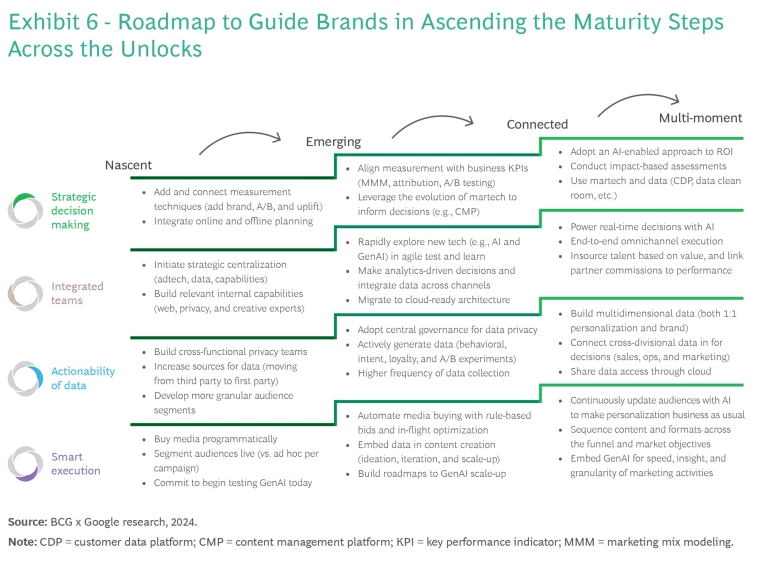
With this roadmap in mind, brands must focus their attention and resources on taking the next step up the maturity curve—regardless of where they are now—and they need to prioritize different unlocks depending on their current level of maturity. For nascent, emerging, and connected brands, we have identified the three most important capabilities to acquire in order to advance to the next level.
Roadmap Priorities for Nascent Brands

Nascent brands should focus on closing the wide maturity gap that separates them from other companies. To achieve the greatest impact in the shortest amount of time, these brands should prioritize three capabilities. (See Exhibit 7.) First, they need to focus on preparing for a cookieless world and ensuring privacy readiness. Second, they need to strategically select appropriate technology and clearly define ownership between brands and partners. Third, brands need to strengthen their investments in digital media to unlock personalization and holistic experiences.
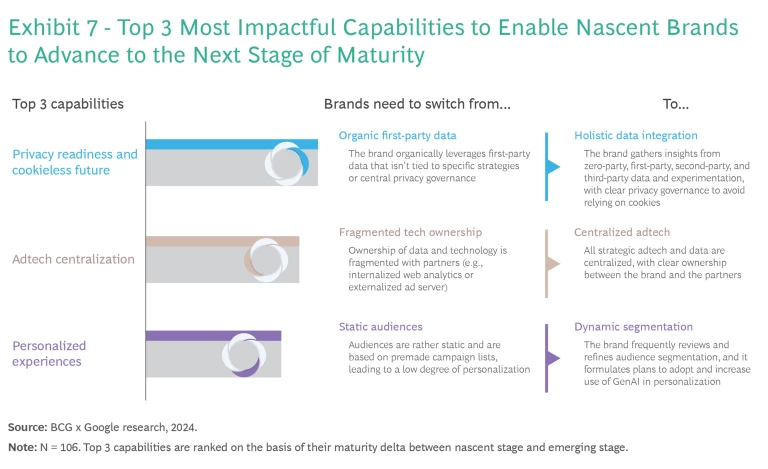
Roadmap Priorities for Emerging Brands

Emerging brands have assembled the basic building blocks for maturity (mainly data quality, and people training and upskilling). Their next challenge is to execute and connect all inputs and outputs into strong and multidimensional systems of measurement that will allow brands to make strategic decisions. To this end, they should focus on three capabilities that will help them unlock value faster and more effectively. (See Exhibit 8.) First, they should prioritize the alignment of KPIs with long-term strategic goals. Second, they should establish end-to-end measurement capabilities. Third, they should invest in AI-driven predictive analytics, and integrate AI and GenAI into their everyday operations.
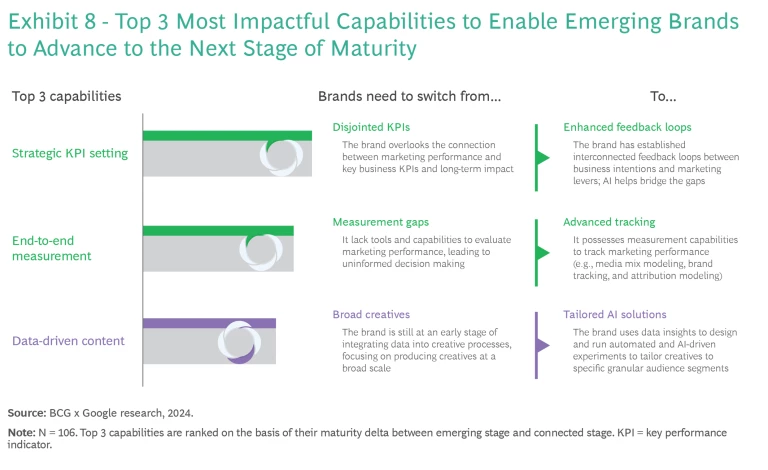
Roadmap Priorities for Connected Brands

Connected brands have built new algorithms, deployed the tech stack, and ensured the right data feeds. But those measures account for only about 30% of what it takes to reach the multi-moment level—the highest stage of maturity. The remaining 70% involves improving change management and other people-related processes to embed innovation as a collaborative way of working. To this end, connected brands should focus on building up three distinct capabilities. (See Exhibit 9.) First, they should capitalize on their tech and digital investments by onboarding the whole organization onto new ways of working, using enhanced agile collaboration and elevated execution. Second, they should strengthen data-driven decision-making processes to help develop a holistic approach to data science and market trend analysis. Third, they should transition from generic creative ideas to leveraging GenAI for hyperpersonalization and embedding AI-driven solutions into all levels of strategy formulation and execution.
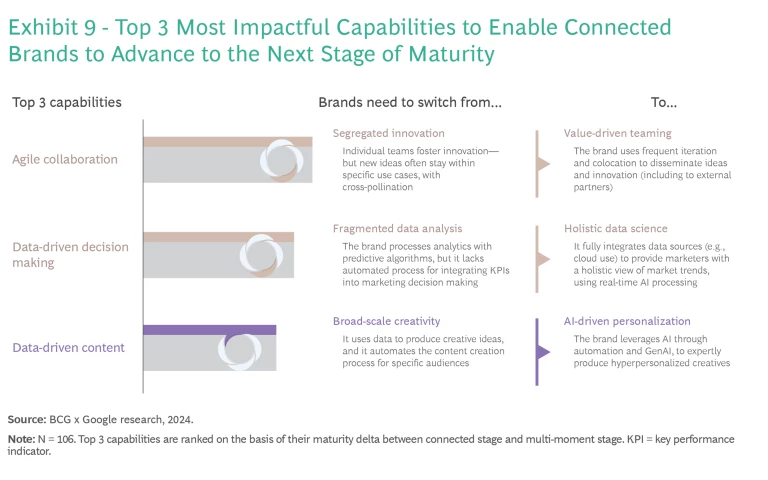
Conclusion
As new and powerful technologies and tools—such as AI and GenAI—continue to emerge, facilitated by widespread adoption of cloud computing, brands have a huge opportunity to improve their marketing maturity and thus increase their productivity, profitability, and overall competitiveness. The skill set necessary for AI-driven marketing maturity is expanding and becoming more demanding, but the potential payoff is significant.
Every brand should assess its position on the maturity curve. By focusing on the capabilities that most powerfully support the four unlocks of AI-driven marketing value, brands can steadily improve their approach and become true innovators, incorporating advanced technologies into their marketing operations.
The authors thank Tommaso Passalacqua, Daniele Frigerio, Frank Hohenleitner, and Ambra Giuliano for their contributions to this study.









